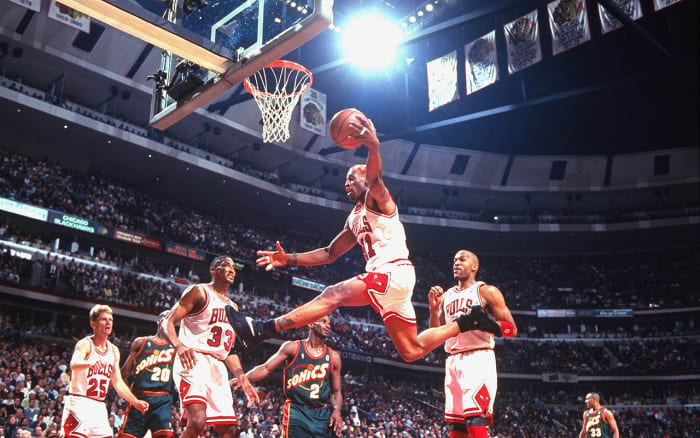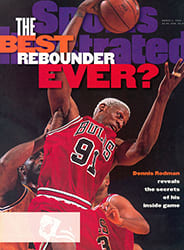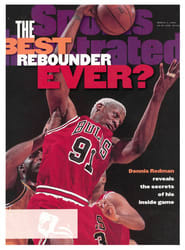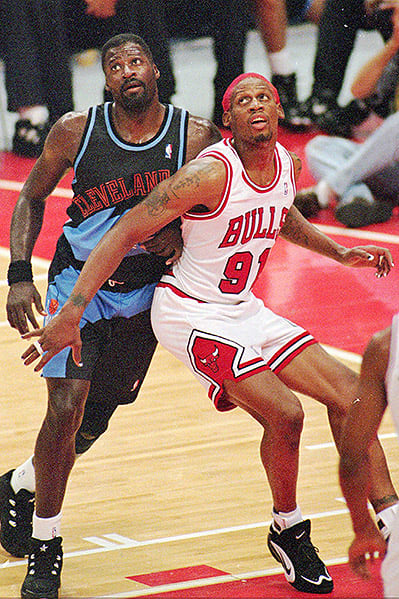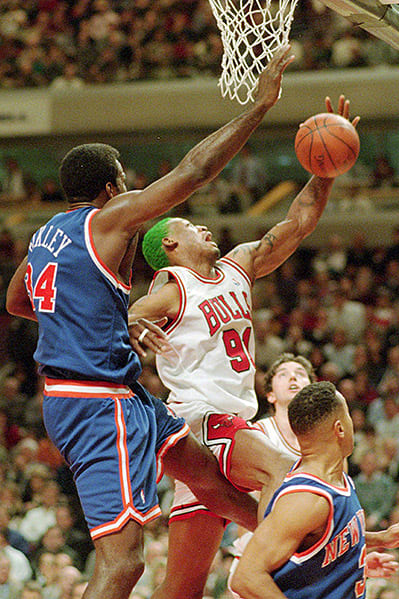Tricks of the Trade
Class is in session in the visitors' locker room of the Miami Arena, and the instructor is a tall, tattooed gentleman with a nose ring, hair dyed a shade of brownish yellow not found in nature and a T-shirt that reads, I DON'T MIND STRAIGHT PEOPLE, AS LONG AS THEY ACT GAY IN PUBLIC. Chicago Bulls forward Dennis Rodman may not look like a teacher, but he is nothing less than a professor of rebounding, and before a game last Friday against the Miami Heat he is holding an impromptu seminar.
Rodman is the only Bull studying the tape of Chicago's game against the Atlanta Hawks the previous night. "Anytime I see Scottie or Michael shoot from the top of the key, I know the ball will come off the rim to the right," he says, referring to teammates Scottie Pippen and Michael Jordan. "Watch this." He fast-forwards the tape until Pippen appears on the big-screen TV, shooting a three-pointer from the top of the key. While the shot is in the air, other players wrestle for position under the basket as Rodman slides into an open space to the right of the hoop. The shot caroms hard toward the right corner, just as he anticipated, and he is the only one in position to chase the ball down. He fast-forwards again, first to another Pippen miss from the top of the key and then to a Jordan miss from the same spot. Both times the ball bounces off to the right, and both times Rodman—who has spent hours observing the arc of their shots—is in position for an uncontested rebound. He looks away from the television, raises his eyebrows and says, "See?"
It was not by accident that through Sunday Rodman led the NBA in rebounding, with an average of 15.4 per game, and that if he maintains his lead, he will become only the second player (the first was Moses Malone) to win five consecutive rebounding titles. As he showed when he had a game-high 17 rebounds in the Bulls' 111-91 victory over the Orlando Magic on Sunday, he rules the backboards because he is relentless, superbly conditioned, a trifle dirty when he needs to be and, perhaps most important, surprisingly analytical. "He compares himself to a computer sometimes," says teammate Jack Haley. "The hardware is his body, which he keeps in peak physical shape, and the software is his knowledge, what he knows about different shooters' tendencies and how shots from certain spots on the floor tend to come off the rim. And dirty? Well, let's just say I have the bite marks and scratches from going up against him in practice."
At the very least Rodman, who has averaged 18.7, 18.3, 17.3 and 16.8 rebounds the last four seasons, deserves a place next to Wilt Chamberlain and Bill Russell as one of the greatest rebounders of all time. An informal SI poll of NBA players, coaches, executives and broadcasters placed Chamberlain at No. 1, Rodman No. 2 and Russell No. 3—with esteemed board men Malone, Paul Silas, Wes Unseld, Charles Barkley, Nate Thurmond, Bob Pettit and Jerry Lucas rounding out the alltime Top 10. An argument over whether Rodman is a better rebounder than Chamberlain or Russell could go on for ages. Chamberlain's career rebounding average was 22.9 and Russell's was 22.5, compared with Rodman's 12.5 entering this season. But Chamberlain and Russell, both centers, played in an era when more shots were taken per game and shooting percentages were lower, and thus there were more rebounds to be had.
However, Rodman's dominance of the backboards is even more remarkable than that of either Hall of Fame pivotman because at 6'8" and 215 pounds he overcomes a size disadvantage faced in their era by neither Chamberlain, who was 7'1" and 275, nor Russell, 6'10" and 225 (and also blessed, as Rodman is, with disproportionately long arms). Thus it is fair to say that, inch-for-inch and pound-for-pound, Rodman is the best rebounder in NBA history. "Wilt was just bigger and stronger than everyone," says TNT analyst Chuck Daly, who coached Rodman when they both were with the Detroit Pistons. "Russell was built more along the lines of Dennis, but he didn't have to go up against power forwards and centers as big as the ones Dennis has to face night after night. When you factor size into the equation, I don't know how you could say there's ever been a better rebounder."
Rodman simultaneously has reduced rebounding to a science while elevating it to an art. He talks dispassionately about angles and trajectories in the locker room, but on the floor he pursues the basketball with passion. After winning a battle for the ball, he will cradle it like a baby, or look at it quizzically as if seeing it for the first time, or whip it quickly to a teammate as though it were some disgusting object. "I rebound with a little flair, a little something extra," he says. "It's not for the crowd, it's just for me. Rebounding is how I express myself on the floor."
He turns back to the TV, switching from the tape of the Bulls-Hawks game to one showing the Heat against the Magic. He is most interested in tonight's opponent, Miami, but he can't help noticing Orlando center Shaquille O'Neal. "Most shots rebound long, to the opposite side, but Shaq's ball is flat, so if he shoots the ball from the side, it's usually going to come back to that same side and quickly," Rodman says. "It'll come off the rim hard, so it will be a long rebound. But take somebody like [Chicago guard] Steve Kerr. He has a high arc on his shots, so I know his rebounds are either going to go straight up or off to the opposite side. Either way, they're going to be pretty close to the rim."
Rodman is warming to the subject now, never taking his eyes off the screen as he talks. "I know shooters, but that's not enough," he says. "You have to watch the flight of the ball. Most guys see the shot go up and they turn and look at the rim, waiting for the ball to come off. I watch the ball in the air and make an adjustment if I need to." When Rodman was traded from the San Antonio Spurs to the Bulls in October, he immediately made a habit of rebounding for Pippen and Jordan during practices as they warmed up so he could get a feel for the caroms that came from their shots. "Most of the time Mike's shots tend to come off to the right of the rim, no matter where he shoots it from, but I don't just take that for granted," Rodman says. "I watch his shot in the air, and I can tell if it's off-line to the left or short, and then I go where I think I need to be."
A typical Rodman game would not be instructional-video material. He takes liberties with the fundamentals, sometimes deciding not to box his man out and instead moving to the spot where he anticipates the rebound will come. His relatively slender build works to his advantage here, because he seems to be able to slip through cracks between players. Like a good outfielder, Rodman appears to get a jump on the ball, moving while the ball is still in the air. Because of that ability, Charlotte Hornets vice president of basketball operations Bob Bass, who held the same job with San Antonio when Rodman joined the Spurs, compared him to Willie Mays.
And if Rodman guesses wrong, he has the ability to adjust quickly. "Dennis can jump at an angle, which is not as easy as it might sound," says Bulls television analyst Johnny (Red) Kerr, who averaged double figures in rebounds for eight straight seasons in the 1950s and '60s with the Syracuse Nationals and the Philadelphia 76ers. "Most guys are straight-up jumpers, but Dennis can adjust his body in the air to get to a ball. The only other player I've seen who could do that was Russell."
The Rodman paradox is that he can look as though he is barely in control of his emotions on the court, on the edge of some outburst, when he is in fact coolly processing information. He is taking into account who the shooter is, the area on the court from which the shooter is firing, the trajectory of the ball, the positioning of his opponents and the percentages, which indicate that most shots will rebound long and to the opposite side of the basket from which they were launched. "People think I just go get the damn ball, because they don't take the time to really look at what I do," he says. "Rebounding isn't brain surgery, but there's more to it than being able to jump higher than the next guy. A lot of the work is done before you ever even jump."
Some of that work is best done away from the referees' gaze. Like every successful rebounder, Rodman has certain tricks he uses to help him gain an advantage. "They're not tricks, they're techniques," he says. He particularly likes to pin his opponent's arm between his own arm and his body, making it impossible for the opponent to jump. He gets called for this fairly often but not nearly as often as he gets away with it. "He's pretty active with his hands," says Cleveland Cavaliers center-forward Michael Cage, who led the league in rebounding in 1987-88. "He'll give you a little nudge in the small of the back just as you're getting ready to jump." When Rodman has inside position, he sometimes crouches down and leans back into his opponent until he is virtually sitting on the other man's thigh, which tends to keep the opponent anchored to the floor. "There might be a couple of other little things I do," he says. "I could tell you, but then I'd have to kill you." Somehow, you believe him.
If Rodman has not revolutionized rebounding, he has at least glamorized it, making the slam-dance under the basket seem like fun when it is in fact grueling, often brutal work. His rebounding skill is what makes it impossible to dismiss him as just an attention-seeking eccentric. "People buy into the image of Dennis as this kind of impulsive flake," says Kerr. "But there's so much more to him than that. He's exceptionally smart and hardworking. It's just that those qualities are harder to spot than the hair colors and the tattoos." That's not to say that Rodman doesn't care about being noticed. "I had dinner with him about a month ago," says Daly. "He said to me, 'You know, I was the best defensive player and the top rebounder in Detroit, and nobody knew who I was. That's why I decided to do some things a little differently.'"
If he ever fulfills his goal of getting 50 rebounds in a game (Chamberlain's 55 are the NBA single-game record), Rodman may do something really different. He has said that his fantasy is to grab number 50, then strip off his uniform and run off the floor naked. Haley no doubt speaks for many when he says that "is something I truly hope I never have to see."
Rodman has certainly won the respect of other top rebounders, both past and present. "His greatest asset is his energy level," says Cage. "He's absolutely tireless. He is to rebounding what Jordan is to offense. If he's your man, you almost have to forget about scoring or helping on defense." Silas, now a Phoenix Suns assistant coach, sees a bit of himself in Rodman. "He's more physically talented than I was," Silas says, "but the way he watches the flight of the ball and anticipates where it will go is similar to what I used to do. The big thing, though, is desire. He just wants the ball more than the other guy."
That desire was the by-product of Rodman's pursuit of a place for himself when he arrived in the NBA as an obscure second-round draft choice out of Southeastern Oklahoma State. "When he first came into the league, he didn't think much of his offensive skills, and rebounding and diving on the floor were the ways for him to get minutes," says Daly. "When he saw how good he was at it, he really started to focus on it."
Indeed, when he is pursuing a ball, Rodman has no concern for his own welfare or anyone else's. During his seven years with Detroit at least one courtside spectator sued him when he accidentally trampled her while trying to keep a ball from going out-of-bounds. (The Pistons settled out of court.) And he once knocked a Detroit sportswriter unconscious when he ran over him while chasing a ball. As these examples show, there is no loose ball that he considers out of his reach, and every time a shot goes up, he believes the rebound will be his. It is revealing that when he describes where certain shooters' rebounds are likely to go, he does not mention the possibility that the shot will go in. "I expect every shot to miss," he says. "To me, every time the ball leaves a shooter's hand, I believe there's a rebound coming."
"He almost never concedes a rebound, " says Cage. "He knows if he can get even a finger on it and keep it alive, he's such a quick jumper that he'll have a chance to get it on the second or third jump." That second or third jump often comes while his opponent is still gathering himself to go up a second time. One of Rodman's greatest assets is that he is a pogo-stick jumper. Notes Toronto Raptors coach Brendan Malone, a Detroit assistant when Rodman was a Piston, "A lot of big guys have to dip their knees and drop their arms before they jump, and by that time Dennis has been in the air two or three times."
Moreover, Rodman is as quick a jumper in the fourth quarter as he is in the first, thanks largely to his remarkable physical condition. Rodman's 34-year-old body shows no signs of the wear and tear of 10 NBA seasons. He bounds up and down the court with a bounce in his stride that suggests he has more energy than he knows what to do with. "He's a Duracell battery," says Haley, Rodman's most vocal cheerleader. "The man doesn't even sweat." Rodman is a maniacal weightlifter, but surprisingly none of his weight work is designed to strengthen those spring-loaded legs, which Rodman believes are already powerful enough; he does ride stationary bicycles and climb on StairMasters.
It is mostly due to Rodman's presence that at week's end Chicago was outrebounding its rivals by an average of 6.9 per game; last season, the Bulls grabbed only one more rebound per game than their foes. But numbers don't do justice to the kind of psychological effect a rebounder like Rodman has on a game. "The only two guys I've ever seen who could dominate a game without scoring are Bill Russell and Dennis Rodman," says Brendan Malone. Rodman's offensive rebounds can be especially demoralizing to an opposing team that has finally forced the Bulls' potent offense into a missed shot. (Through Sunday, Rodman led the league in offensive boards, averaging 5.67.) "His tip-ins are sometimes amazing," says Chicago coach Phil Jackson. "On one play he was almost directly under the backboard, and he somehow tipped the ball so that it banked off the backboard and went into the basket. It was no accident. He's got tipping angles that amaze me."
But Jackson doesn't deny that Rodman's obsession with rebounds sometimes is, as he puts it, "an obstruction to the team." When the Bulls are on defense, Jackson has seen Rodman leave his man on one side of the basket and move over to the other side of the rim because the rebound was more likely to go in that direction. "There might be a 65 percent chance the ball will go to Dennis's side, but that other 35 percent will mean a layup for his man," Jackson says.
And there are those who believe that part of the reason for Rodman's rebounding success is that he is allowed the luxury of concentrating almost solely on that area. "He's a great rebounder, but he's also a very one-dimensional player," says Unseld, now the Washington Bullets' executive vice president. "I believe there are other players, like [the Suns'] Charles Barkley, who could put up similar numbers if they played the same role Rodman does."
That may be true, but it's hard to imagine any other player exceeding the amount of thought Rodman puts into his specialty. As he watches the tape in the locker room, he sees himself grabbing or contesting almost every rebound. But during one sequence several shots in a row bounce far away from him in another direction. "I was guessing wrong there," he says. "But you watch. The next rebound is mine."
COLOR PHOTO: COVER PHOTOGRAPH BY RICHARD MACKSON COVER PHOTO THE BEST REBOUNDER EVER? Dennis Rodman reveals the secrets of his inside
gameCOLOR PHOTO: NOREN TROTMAN/NBA PHOTOS [Dennis Rodman wrestling for position with opponent]COLOR PHOTO: ROCKY WIDNER [Overhead view of Dennis Rodman at basket]COLOR PHOTO: NATHANIEL S. BUTLER/NBA PHOTOS [Dennis Rodman, David Robinson, and others wrestling for position]COLOR PHOTO: BILL FRAKES [Dennis Rodman positioning himself for rebound as Steve Kerr shoots basketball]COLOR PHOTO: SCOTT CUNNINGHAM/NBA PHOTOS [Dennis Rodman rebounding basketball against Orlando Magic]
"Dennis can adjust his body in the air to get to a ball. The only other player I've seen who could do that was Russell."
"Like every successful rebounder, Rodman has tricks he uses to gain an advantage."
"Take somebody like Steve Kerr. He has a high arc on his shots, so I know his rebounds are going to be pretty close to the rim."
"I rebound with a little flair, a little something extra. Rebounding is how I express myself on the floor."
